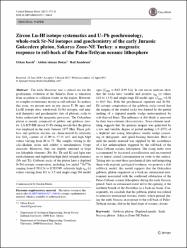Zircon Lu-Hf isotope systematics and U-Pb geochronology, whole-rock Sr-Nd isotopes and geochemistry of the early Jurassic Gokcedere pluton, Sakarya Zone-NE Turkey: a magmatic response to roll-back of the Paleo-Tethyan oceanic lithosphere
Citation
Karslı, O., Dokuz, A. & Kandemir, R. (2017). Zircon Lu-Hf isotope systematics and U-Pb geochronology, whole-rock Sr-Nd isotopes and geochemistry of the early Jurassic Gokcedere pluton, Sakarya Zone-NE Turkey: a magmatic response to roll-back of the Paleo-Tethyan oceanic lithosphere. Contributions To Mineralogy and Petrology, 172(5), 31. https://doi.org/10.1007/s00410-017-1346-0Abstract
The early Mesozoic was a critical era for the geodynamic evolution of the Sakarya Zone as transition from accretion to collision events in the region. However, its complex evolutionary history is still debated. To address this issue, we present new in situ zircon U-Pb ages and Lu-Hf isotope data, whole-rock Sr-Nd isotopes, and mineral chemistry and geochemistry data of plutonic rocks to better understand the magmatic processes. the Gokcedere pluton is mainly composed of gabbro and gabbroic diorite. LA-ICP-MS zircon U-Pb dating reveals that the pluton was emplaced in the early Jurassic (177 Ma). These gabbros and gabbroic diorites are characterized by relatively low SiO2 content of 47.09 to 57.15 wt% and high Mg# values varying from 46 to 75. the samples belong to the calc-alkaline series and exhibit a metaluminous I-type character. Moreover, they are slightly enriched in large ion lithophile elements (Rb, Ba, Th and K) and light rare earth elements and depleted in high field strength elements (Nb and Ti). Gabbroic rocks of the pluton have a depleted Sr-Nd isotopic composition, including low initial Sr-87/Sr-86 ranging from 0.705124 to 0.705599, relatively high epsilon(Nd) (t) values varying from 0.1 to 3.5 and single-stage Nd model ages (T-DM1 = 0.65-0.95 Ga). in situ zircon analyses show that the rocks have variable and positive epsilon(Hf) (t) values (4.6 to 13.5) and single-stage Hf model ages (T-DM1 = 0.30 to 0.65 Ga). Both the geochemical signature and Sr-Nd-Hf isotopic composition of the gabbroic rocks reveal that the magma of the studied rocks was formed by the partial melting of a depleted mantle wedge metasomatized by slab-derived fluids. the influence of slab fluids is mirrored by their trace-element characteristics. Trace-element modeling suggests that the primary magma was generated by a low and variable degree of partial melting (similar to 5-15%) of a depleted and young lithospheric mantle wedge consisting of phlogopite-and spinel-bearing lherzolite. Heat to melt the mantle material was supplied by the ascendance of a hot asthenosphere triggered by the roll-back of the Paleo-Tethyan oceanic lithosphere. the rising melts were accompanied by fractional crystallization and encountered no or minor crustal contamination en route to the surface. Taking into account these geochemical data and integrating them with regional geological evidence, we propose a slab roll-back model; this model suggests that the Gokcedere gabbroic pluton originated in a back-arc extensional environment associated with the southward subduction of the Paleo-Tethyan oceanic lithosphere during the early Jurassic period. Such an extensional event led to the opening of the northern branch of the Neotethys as a back-arc basin. Consequently, we conclude that the gabbroic pluton was related to intensive extensional tectonic events, which peaked during the early Jurassic in response to the roll-back of Paleo-Tethyan oceanic slab in the final stage of oceanic closure.


















